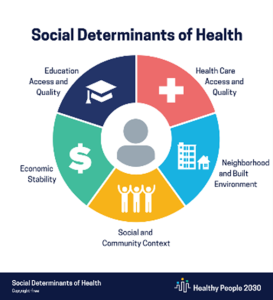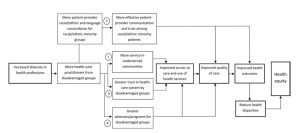2 Social Determinants of Health
Learning Objectives
- Discuss SDOH and how the SDOH impacts people where they live, work, and play.
- Recognize the importance of the SDOH in nursing students.
- Recognize that patients are people who are impacted by the SDOH.
Social Determinants of Health
The SDOH includes “the conditions in the environments where people are born, live, learn, work, play, worship, and age that affect a wide range of health, functioning, and quality-of-life outcomes and risks” (U.S. Department of Health and Human Services [USHHS], 2023, n.p.).
These determinants go beyond the traditional medical model and encompass a wide range of social, economic, and environmental factors such as socioeconomic status, education, neighborhood and physical environment, employment, and social support networks.
Figure 2-1 Social Determinants of Health

Note: Healthy People 2030 (USHHS, 2023, n.p.).
Understanding the importance of SDOH is crucial for nurses, as they are often at the forefront of patient care and can witness firsthand the impact of these factors on individuals’ health and well-being (Fortes et al., 2022). For example, a nurse caring for a patient recovering from a heart attack may discover that the patient lives in a food desert, making it challenging to access healthy food options and adhere to dietary recommendations (Fortes et al., 2022). In such cases, the nurse can act as an advocate and connect the patient with community resources that can assist with food access.
Figure 2-2 Food Desert

Nursing education programs have historically focused on preparing students for acute care settings. However, there is a growing need to integrate SDOH, population health, and health equity into nursing curricula to adequately prepare nurses to address the complex health needs of diverse populations [National Academies of Sciences, E., & Medicine (NASEM), 2021]. Nursing organizations, such as the American Association of Colleges of Nursing (AACN) and the National League for Nursing (NLN), have developed guidelines to incorporate these essential concepts into nursing education.
One crucial aspect of addressing SDOH is for nursing students to learn how to connect with patients on a personal level, utilizing their own experiences to build rapport and foster trust.
While respecting professional boundaries, nurses can draw upon their own life experiences to empathize with patients and understand their unique challenges. For instance, a student who has experienced financial hardship might better understand the struggles of a patient who is unable to afford their medications. This shared understanding can create a stronger patient-nurse relationship and facilitate open communication about sensitive topics.
Connecting with patients through shared experiences can also help nurses understand the cultural and social contexts that influence health behaviors and outcomes. A student who has grown up in a community with limited access to health care may be more attuned to the barriers a patient from a similar background faces. By recognizing and acknowledging these barriers, nurses can provide more patient-centered care and develop tailored interventions that are more likely to be effective (University of St. Augustine for Health Sciences, 2024).
Furthermore, personal connections can help bridge authority gradients, which refer to the perceived power differences between individuals in a hierarchical structure such as a health care team (Acquaviva et al., 2013). By establishing a rapport built on shared experiences, nurses can create a more egalitarian environment that encourages patients to actively participate in their care (Acquaviva et al., 2013). This shared decision-making can empower patients and improve adherence to treatment plans.
Ultimately, connecting with patients through personal experiences is not about disclosing personal information inappropriately; it is about leveraging shared understanding to build trust, empathy, and rapport. These connections can be invaluable tools for nurses seeking to address SDOH and provide holistic, patient-centered care that recognizes the multifaceted influences on health and well-being (Fortes et al., 2022).
Recognition of the Importance of SDOH for Nursing Students
The Future of Nursing 2020-2030 identifies three core nursing competencies to be addressed by nursing education surrounding social determinants of health (SDOH) (National Academies of Sciences [NASEM], 2021). First, the ability of nurses to be aware of implicit bias in the delivery of person-centered care with “empathy and humility” (NASEM, 2021, p. 205). Second, the ability to collaborate and provide care that addresses SDOH “is necessarily a multisectoral endeavor” and includes many issues such as “housing, education, justice, and the environment” that require working with an interdisciplinary team (NASEM, 2021, p. 205). Third, the ability to adapt practice that uses technology without “exacerbating existing disparities and inequities” (NASEM, 2021, p. 205).
The increasingly technological environment in nursing has created a gap where the caring relationship between nurses and patients may suffer (Honkavuo & Abo, 2020).
The SDOH affects the population in ways that can be subtle and under-recognized and in ways that can be radical and obvious within communities. A wide spectrum of factors exists and can include environmental, financial, and geographic concerns. Political factors such as historical trauma and immigration laws are impacting indigenous and immigrant communities (Perez et al., 2019). The lack of inclusivity, diversity, and equity related to ethnicity, race, gender orientation, and ageism are prominent concerns affecting most communities (Matthews et al., 2022; Perez et al., 2019).
Factors specifically affecting students as structural barriers to higher education can include “poverty, poor high school education, and parental education” additionally, “limited supports are in place to assist students who are differently impacted by traumatic societal events” for instance pandemic and civil unrest (Matthews et al., 2022, p. 97). These factors within urban and rural communities affect nursing students and nurse educators in the receipt and delivery of nursing education and ultimately the provision of high-quality person-centered care (Lee et al., 2023; Perez et al., 2019).
Social Determinants of Health Affecting Nursing Students in Oklahoma
The SDOH affects the population in ways that can be subtle and under-recognized and in ways that can be radical and obvious within communities. A wide spectrum of factors exists and can include environmental, financial, and geographic concerns. Political factors such as historical trauma and immigration laws are impacting indigenous and immigrant communities (Perez et al., 2019). The lack of inclusivity, diversity, and equity related to ethnicity, race, gender orientation, and ageism are prominent concerns affecting most communities (Matthews et al., 2022; Perez et al., 2019).
Factors specifically affecting students as structural barriers to higher education can include “poverty, poor high school education, and parental education”; additionally, “limited supports are in place to assist students who are differently impacted by traumatic societal events” for instance pandemic and civil unrest (Matthews et al., 2022, p. 97). These factors within urban and rural communities affect nursing students and nurse educators in the receipt and delivery of nursing education and ultimately the provision of high-quality person-centered care (Lee et al., 2023; Perez et al., 2019).
The most current pre-licensure RN graduate’s gender and diversity statistics in Oklahoma ADN and BSN programs compared to the total U.S. population (%) reported in the Future of Nursing: Campaign for Action (NASEM, 2022) Dashboard included: In the U.S., the female/male population is 50.8% female and 49.2% male. In 2020, pre-licensure RN program graduates were 85.3% female and 13.9% male. In addition, program graduates were 61.4% (59.7%) white, 10.7% (12.6%) African American, 0.6% (0.7%) American Indian or Native American, 6.5% (5.9%) Asian, 0.3% (0.2%) Native Hawaiian or Pacific Islander, 12.4% (18.6%) Hispanic or Latino, 3.1% (2.3%) Two or more races, 0.8% (NA) Non-US Residents International, and 4.2% (NA) Race/Ethnicity unknown (p. 8) (Brown, 2024). Male graduate nurses in Oklahoma nursing programs were underrepresented by 35.3% in relation to the general population (Brown, 2024). White, American Indian or Native American, Asian, Hispanic, or Latino program graduates were reported higher than the general population (Brown, 2024). African American and Native Hawaiian or Pacific Islander program graduates were reported below the general population (Brown, 2024).
Perez et al.’s (2022) findings included that all populations would benefit from the provision of health care that considers the SDOH. The model (Figure 2-3) could be used in nursing education, replacing the term health professions for nursing students/education. The homogeneity in nursing being mostly white and female is of concern as research is demonstrating the care patients receive and the perception of the quality of care can be linked to a lack of racial/ethnic concordance (Matthews et al., 2022). A more diverse nursing workforce would positively impact the care of diverse populations. Concordance improves “patient-provider communication, trust, and decision-making, thereby increasing access to, and quality of the interaction-which would result in improved health outcomes” (Perez et al., 2019, p. 7).
Figure 2-3 Expanded conceptual framework linking health professions’ diversity to health disparity and health equity outcomes

Note: Adapted from: U.S. Department of Health and Human Services, Health Resources and Services Administration, Bureau of Health Professions. The rationale for diversity in the health professions: a review of the evidence. Rockville, Md.: HHS; 2006. https://campaignforaction.org/wp-content/uploads/2019/11/SDOH-Populations_Research_Workforce_Final.pdf
Figure 2-4 SDOH affecting nursing students in rural Oklahoma

Oklahoma is reported to be the 5th highest state for poverty rate in the United States at 15.7%. In 2023 poverty level for a single individual was $14,580 and $30,000 for a family of four (Oklahoma Policy Institute, 2023). Additionally, the rate of poverty for American Indians in Oklahoma is disproportionate to the overall rate of poverty at 18.1% in 2021 and increased to 20.4% in 2022 (Oklahoma Policy Institute, 2023).
In a study conducted by Brown (2024) approximately 63.4% of first-year nursing students in Oklahoma are living below the poverty level according to study findings regardless of race/ethnicity. These findings correlate with general structural barriers including poverty, poor high school education, and student support that is limited. These barriers to higher education affect many students’ ability to seek and complete higher education goals. SDOH and demographics bivariate analysis discovered significance in the race/ethnicity category and was significantly correlated with food scarcity (.033), lack of transportation (.000), obtaining medications (.042), violence/abuse (.001), managing medical conditions (.000), and financial abuse (.004). 39% of the total sample ranked worry over food scarcity as sometimes, often, and very often, and 35.6% of the total sample reported transportation had kept them from medical appointments or things needed for daily living and obtaining medications or supplies. 17% of the total participants reported violence/abuse. 5% were not confident regarding managing medical conditions day to day. Financial abuse was reported by 23.8% of the total participants.
Reflective Journal
How have the SDOH, such as socioeconomic status, education, or neighborhood environment, impacted the health outcomes of patients you have cared for?
- Reflect on specific examples and consider how these factors may have influenced patients’ access to healthcare, adherence to treatment plans, or overall well-being.
How can nurses utilize their own experiences, while respecting professional boundaries, to empathize with patients and provide more patient-centered care?
- Consider how your background and life experiences can inform your interactions with patients from diverse backgrounds and facing various SDOH-related challenges.
GLOSSARY
- SDOH: Social Determinants of Health encompasses the conditions in environments where individuals are born, live, learn, work, play, worship, and age, impacting their health, functioning, and quality of life. These factors extend beyond traditional medical care and include socioeconomic status, education, neighborhood characteristics, employment, and social support networks.
- Authority Gradients: Authority gradients refer to perceived power imbalances between individuals within hierarchical systems like healthcare teams. Building rapport through shared experiences can mitigate these power differences, fostering a more egalitarian environment where patients actively participate in their care.
- Implicit Bias: Implicit bias refers to unconscious attitudes or stereotypes that influence an individual’s understanding, actions, and decisions. Nurses must recognize and address implicit bias to provide person-centered care with empathy and humility.
- Health Equity: Health equity exists when everyone has a fair and just opportunity to attain their highest level of health. Achieving health equity requires addressing the social determinants of health and dismantling systemic barriers that create disparities in health outcomes.
- Racial/Ethnic Concordance: Racial/ethnic concordance occurs when patients and healthcare providers share the same racial or ethnic background. Research suggests that concordance can improve patient-provider communication, trust, and shared decision-making, leading to better health outcomes.
- Food Desert: A food desert is a geographic area where access to affordable and nutritious food is limited or nonexistent. This lack of access can contribute to poor diet and nutrition-related health problems.
NCLEX Practice Questions
Question 1
A new graduate nurse is feeling overwhelmed and unprepared for the demands of their role. Which of the following factors is LEAST likely contributing to their experience
a) Heavy patient loads
b) High turnover rates
c) Inexperienced coworkers
d) Supportive learning environments
Question 2
Which teaching practice is MOST likely to prepare nursing students for the realities of modern nursing practice?
a) Focusing primarily on didactic lectures
b) Integrating cognitive unmooring questions into patient assessments
c) Limiting simulation experiences to basic skills
d) Emphasizing individual learning over teamwork
Question 3
A nursing student is struggling to balance their personal life with the demands of their nursing program. Which university resource is MOST likely to provide direct support in addressing this challenge?
a) Nurse coach
b) Campus sports activities
c) Career coach
d) SON writing tutors
Question 4
Which nursing intervention BEST reflects the principles of relational ethics in patient care?
a) Completing tasks efficiently without engaging in personal conversations
b) Actively listening to the patient’s concerns and perspectives
c) Prioritizing the physician’s orders over the patient’s preferences
d) Maintaining a detached and professional demeanor at all times
Question 5
Here are three NCLEX-style questions focused on the Social Determinants of Health (SDOH) in a clinic setting, which are relevant to nursing students:
A nurse is caring for a patient who is recovering from a stroke and has limited mobility. The patient lives in a rural area with limited access to public transportation. Which of the following SDOH is most likely to impact the patient’s ability to attend follow-up appointments and participate in rehabilitation?
a) Access to healthy food options
b) Environmental pollution
c) Transportation barriers
d) Social isolation
Question 6
A nursing student is working with a preceptor in a community clinic. The student observes that many patients struggle to afford their medications. Which action by the nursing student demonstrates an understanding of the impact of SDOH on patient care?
a) Suggesting that the patients ask their families for financial assistance
b) Providing patients with information about prescription assistance programs
c) Explaining to the patients that they should try to prioritize their medications over other expenses
d) Recommending that the patients switch to less expensive, over-the-counter alternatives
For Enriched Learning:
https://www.ruralhealthinfo.org/topics/food-and-hunger
References:
Acquaviva, K., Haskell, H., Johnson, J. (2013). Human cognition and the dynamics of failure to rescue: The Lewis Blackman case. Journal of Professional Nursing, 29(2), 95-101. https://doi.org/10.1016/j.profnurs.2012.12.009.
Brown, Cynthia, “Impact of Social Determinants of Health on Skill of Involvement: Differences in First Year ADN and BSN Nursing Students in Rural Oklahoma” (2024). Dissertations. 2230. https://aquila.usm.edu/dissertations/2230
Fortes, K., Latham, C. L., Vaughn, S., & Preston, K. (2022). The influence of social determinants of education on nursing student persistence and professional values. Journal of Professional Nursing, 39, 41–53. https://doi.org/10.1016/j.profnurs.2021.12.005
Lee, T., Damiran, D., Konlan, K. D., Ji, Y., Yoon, Y. S., & Ji, H. (2023). Factors related to readiness for practice among undergraduate nursing students: A systematic review. Nurse Education in Practice, 69, 103614. https://doi.org/10.1016/J.NEPR.2023.103614
Matthews, A. K., Abboud, S., Smith, A. U., Smith, C., Jeremiah, R., Hart, A., & Weaver, T. (2022). Strategies to address structural and institutional barriers to success among students of color in nursing programs. Journal of Professional Nursing, 40, 96–104. https://doi.org/10.1016/J.PROFNURS.2022.03.005
National Academies of Sciences, E., & Medicine (NASEM). (2021). The Future of Nursing 2020-2030: Charting a Path to Achieve Health Equity. (M. K. Wakefield, D. R. Williams, S. Le Menestrel, & J. L. Flaubert, Eds.). National Academies Press. https://doi.org/10.17226/25982
Oklahoma Policy Institute. (2023). Federal poverty level. https://okpolicy.org/federal-poverty-level/#:~:text=The%20federal%20poverty%20level%20%2C%20which,family%20of%20four%20in%202023.
Perez, A. G., Mertz, L., Brassard, A., Alvarez, C., Williams, E. J., Smith, B. K., Littlejohn, S., Cuellar, N., Dawson, M., Joy Garcia-Dia, M., consultants Kupiri Ackerman-Barger, committee, Eddie, R., Martin, L., & Nichols, B. (2019). A literature scan and framework of a diverse nursing workforce and its effect on the social determinants of health We appreciate the review and contributions of the Campaign for Action’s Equity, Diversity, and Inclusion Steering Committee. Future of Nursing: Campaign for Action at the Center to Champion Nursing in America. https://campaignforaction.org/
University of St. Augustine for Health Sciences. (2024). Nursing MSN & DNP Blog The Importance of Communication. https://www.usa.edu/blog/communication-in-nursing/#:~:text=Patient%2Dcentered%20relationships%20are%20critical,patient%20getting%20to%20know%20them.
U.S. Department of Health and Human Services (USHHS). (2023). Healthy People 2023 Social Determinants of Health. https://health.gov/healthypeople/priority-areas/social-determinants-health

